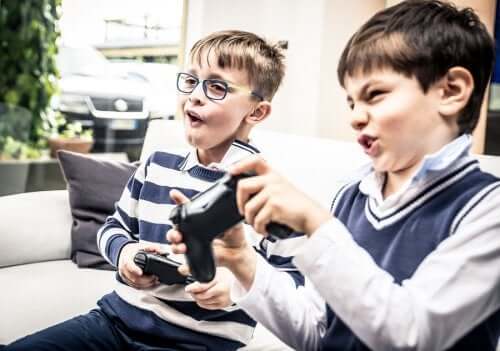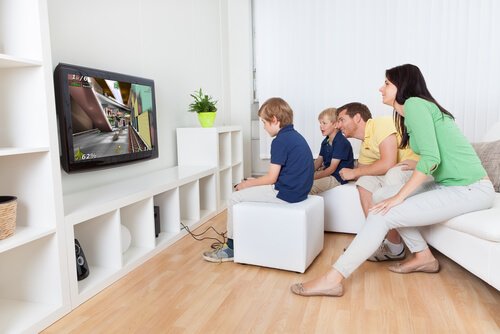Video Games During Childhood: Are They Sources of Violence?

While some say that video games during childhood are a source of violence, others emphasize that they’re not. Despite sufficient knowledge and research on the subject, there’s still conflicting opinions.
Video games during childhood
According to information from the American Academy of Child and Adolescent Psychiatry, playing video games has become a popular activity for people of all ages. Many children and adolescents spend an enormous amount of time playing them.
According to researchers from the same scientific society, “Some games connect to the internet, which allows children and adolescents to play online with adults and peers they don’t know.” In addition, while some games have educational content, most of the popular games emphasize negative themes and promote:
- Killing people and animals
- Use and abuse of drugs and alcohol
- Criminal behavior, lack of respect for authority and laws

- Sexual exploitation and violence against women
- Racial, sexual and gender stereotypes
- Use of swear words and obscene gestures
However, it’s important to note that some video games can facilitate learning and contribute to solving problems, as well as help with motor skills. However, when it comes to violent video games, people are concerned about their effect on young people who play them excessively.
Video games during childhood: Are they a source of violence?
Facts to consider
Studies of children exposed to violence, as highlighted by the American Academy of Child and Adolescent Psychiatry, have shown that they can:
- “Become ‘immune’ or insensitive to the horror of violence, imitate the violence they see, and demonstrate more aggressive behavior due to increased exposure to violence.
- Some children start to think violence is the only way to handle problems. Studies have also shown that the more realistic and repeated the exposure to violence, the greater the impact on children. In addition, children with emotional, behavioral and learning problems may be more affected by violent images.”
In addition, Carlos Brenes Peralta and collaborators emphasize that “Currently, there’s a detailed study on aggression and the use of video games.”
Several studies suggest that “A majority of video game players prefer games that include violent content.”
Also, among the conclusions of the study carried out by Brenes Peralta and his team, it’s pointed out that “It’s important to research the influence of different types of games since it’s possible that some favor more social use, be it competitive or cooperative, while others encourage a more solitary interaction between player and technology.”

Screen exposure time
It’s important to not lose sight of the initial question of whether video games during childhood are a source of violence. Finding the correct answer is essential. However, we also can’t neglect the recommended daily screen time that different scientific entities have established.
Are video games during childhood a source of violence?
It’s no small task to look at video game content and decide to what extent they may or may not be harmful during childhood.
In particular, playing video games during adolescence can help your child with socialization. However, at the same time, they can also increase loneliness, even though that sounds contradictory. Because of that, parents should respectfully supervise the content their children are exposed to. However, you have to be sure you’re not being intrusive.
Finally, it’s especially recommended to stay updated on the advancements and news surrounding video games. That information is always essential to know.
While some say that video games during childhood are a source of violence, others emphasize that they’re not. Despite sufficient knowledge and research on the subject, there’s still conflicting opinions.
Video games during childhood
According to information from the American Academy of Child and Adolescent Psychiatry, playing video games has become a popular activity for people of all ages. Many children and adolescents spend an enormous amount of time playing them.
According to researchers from the same scientific society, “Some games connect to the internet, which allows children and adolescents to play online with adults and peers they don’t know.” In addition, while some games have educational content, most of the popular games emphasize negative themes and promote:
- Killing people and animals
- Use and abuse of drugs and alcohol
- Criminal behavior, lack of respect for authority and laws

- Sexual exploitation and violence against women
- Racial, sexual and gender stereotypes
- Use of swear words and obscene gestures
However, it’s important to note that some video games can facilitate learning and contribute to solving problems, as well as help with motor skills. However, when it comes to violent video games, people are concerned about their effect on young people who play them excessively.
Video games during childhood: Are they a source of violence?
Facts to consider
Studies of children exposed to violence, as highlighted by the American Academy of Child and Adolescent Psychiatry, have shown that they can:
- “Become ‘immune’ or insensitive to the horror of violence, imitate the violence they see, and demonstrate more aggressive behavior due to increased exposure to violence.
- Some children start to think violence is the only way to handle problems. Studies have also shown that the more realistic and repeated the exposure to violence, the greater the impact on children. In addition, children with emotional, behavioral and learning problems may be more affected by violent images.”
In addition, Carlos Brenes Peralta and collaborators emphasize that “Currently, there’s a detailed study on aggression and the use of video games.”
Several studies suggest that “A majority of video game players prefer games that include violent content.”
Also, among the conclusions of the study carried out by Brenes Peralta and his team, it’s pointed out that “It’s important to research the influence of different types of games since it’s possible that some favor more social use, be it competitive or cooperative, while others encourage a more solitary interaction between player and technology.”

Screen exposure time
It’s important to not lose sight of the initial question of whether video games during childhood are a source of violence. Finding the correct answer is essential. However, we also can’t neglect the recommended daily screen time that different scientific entities have established.
Are video games during childhood a source of violence?
It’s no small task to look at video game content and decide to what extent they may or may not be harmful during childhood.
In particular, playing video games during adolescence can help your child with socialization. However, at the same time, they can also increase loneliness, even though that sounds contradictory. Because of that, parents should respectfully supervise the content their children are exposed to. However, you have to be sure you’re not being intrusive.
Finally, it’s especially recommended to stay updated on the advancements and news surrounding video games. That information is always essential to know.
All cited sources were thoroughly reviewed by our team to ensure their quality, reliability, currency, and validity. The bibliography of this article was considered reliable and of academic or scientific accuracy.
- American Academy of Child and Adolescent Psychiatry
- Brenes-Peralta, C. & Pérez-Sánchez, R. (2015). Empatía y agresión en el uso de videojuegos en niños y niñas. Revista Latinoamericana de Ciencias Sociales, Niñez y Juventud, 13 (1), pp. 183-194.
This text is provided for informational purposes only and does not replace consultation with a professional. If in doubt, consult your specialist.








